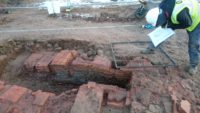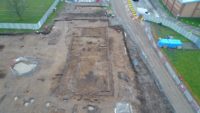 King’s High School in Warwick is going to have the coolest (in the history nerd sense of the word) campus in the county, possibly in the country, after the remains of large Roman villa were unearthed at its new location on Banbury Road. Archaeologists discovered the villa during a preventative excavation before the construction of the new school building. The wall foundations indicate the villa was more than 28 meters (92 feet) long and 14.5 meters (48 feet) wide making it the largest building seen in the region up until that point. It’s the size of a medieval church.
King’s High School in Warwick is going to have the coolest (in the history nerd sense of the word) campus in the county, possibly in the country, after the remains of large Roman villa were unearthed at its new location on Banbury Road. Archaeologists discovered the villa during a preventative excavation before the construction of the new school building. The wall foundations indicate the villa was more than 28 meters (92 feet) long and 14.5 meters (48 feet) wide making it the largest building seen in the region up until that point. It’s the size of a medieval church.
It was built of local sandstone in the 2nd century A.D. and remained in use into the 4th century. It was not purely residential. Archaeologists found corn drying ovens inside and outside the walls, which suggests the villa performed agricultural duties. On the other side of the structure there are wall divisions that were likely living quarters, so the villa served as both dwelling and workspace. The building was likely part of a larger estate that stretched to the Avon river and the Roman roads.
Caroline Rann, who has been leading the winter-long excavation, added: “Very rarely do archaeologists discover a new villa, and this fantastic building could never have been predicted.
“Thanks to the Warwick Independent Schools Foundation and their construction team, Speller Metcalfe, who have gone out of their way to assist us, we can now start to build a better picture of Roman Warwick.”
Simon Jones, secretary for Warwick Independent Schools Foundation, which runs King’s High and Warwick School, said: “This is an exciting find and an invaluable experience for the schools, with pupils and staff having had opportunities to see the excavations at first hand.
“The county archaeologist’s team have been only too happy to share their enthusiasm and worked with us to ensure the find has not had undue impact on POC progress.
“The find will become part of the history of the new school building and of the foundation as a whole and will, we hope, inspire budding archaeologists for generations to come.”
 The school plans to preserve the remains of walls in situ as the campus goes up around it. I hope they do one of those transparent floor things because that would be awesome. As of now, they’re planning to create exhibitions and a portfolio of educational materials for the public and, of course, the lucky, lucky students. There will also be a formal archaeological report released. The first phase of the construction is scheduled to be completed in September 2019.
The school plans to preserve the remains of walls in situ as the campus goes up around it. I hope they do one of those transparent floor things because that would be awesome. As of now, they’re planning to create exhibitions and a portfolio of educational materials for the public and, of course, the lucky, lucky students. There will also be a formal archaeological report released. The first phase of the construction is scheduled to be completed in September 2019.